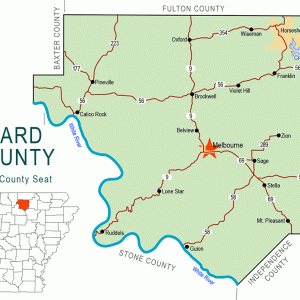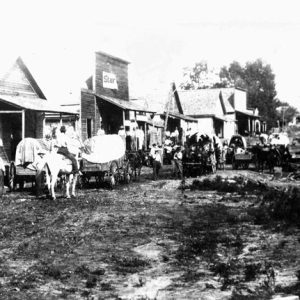calsfoundation@cals.org
Mount Pleasant (Izard County)
| Latitude and Longitude: | 35º57’42″N 091º45’21″W |
| Elevation: | 614 feet |
| Area: | 3.50 square miles (2020 Census) |
| Population: | 353 (2020 Census) |
| Incorporation Date: | November 1, 1963 |
Historical Population as per the U.S. Census:
|
1810 |
1820 |
1830 |
1840 |
1850 |
1860 |
1870 |
1880 |
1890 |
1900 |
|
– |
– |
– |
– |
– |
– |
– |
– |
– |
– |
|
1910 |
1920 |
1930 |
1940 |
1950 |
1960 |
1970 |
1980 |
1990 |
2000 |
|
– |
– |
– |
– |
– |
– |
346 |
438 |
422 |
401 |
|
2010 |
2020 | ||||||||
|
414 |
353 |
The town of Mount Pleasant was established in extreme northwestern Independence County shortly after the close of the Civil War. However, changes in the Izard/Independence county line in 1873 caused the town to be shifted to Izard County. In the twenty-first century, Mount Pleasant is one mile from Independence County and about two miles from Sharp County.
One of the pioneer trails into the interior of Izard County followed Poke (or Polk) Bayou from Batesville (Independence County) northward and then traced Barren Fork Creek northwest toward present-day Melbourne (Izard County). During the 1860s, a new trail was cut one mile south of the creek and passed by the log home of Milton L. Shaver. Soon, the Shaver family converted one room of their home into a general store. A few hundred yards up the trail, John Ed Rudolph established a blacksmith shop. The 1870 U.S. Census lists the blacksmith, two stores, a carpenter, and three preachers in the area.
When Shaver filed for a post office inside his store, he named it Barren Fork. It was approved on May 25, 1876. By the time the census was taken in 1880, the little town had grown to include three stores, two blacksmith shops, a tinsmith, a physician, a teacher, a carpenter, a wagon maker, and six preachers. In addition, the local citizens had erected an impressive two-story school named Mount Pleasant Academy. This institution, opened in 1878, attracted scholars from throughout the region, utilizing almost all area farmhouses as boarding places for students.
A. G. Albright, a merchant at Barren Fork in 1888, wrote a letter to an old friend in which he described the community: “We have a very flourishing little place here (about 200 citizens) with three stores and two blacksmith shops, one cotton gin, a grist mill and a good school. I have bought 1300 bales of cotton this (past) year…and (done) about $60,000 in business.”
After the old academy burned on January 10, 1905, another two-story private school was erected on the same spot. About four years later, the academy became a public school, and by 1925, it was an accredited twelve-grade school. The town continued to grow into the twentieth century, with more than a dozen commercial outlets, including general and drug stores, professional offices, a modern hotel, and a steam-powered flour mill/cotton gin. The Bank of Barren Fork was chartered on October 30, 1913. The school sponsored social activities, young men formed a baseball team, and a volunteer brass band organized—all adding to the enjoyment of life in the farming community.
Oscar P. Moore, a prominent citizen during the early 1900s, owned all or parts of several businesses in Barren Fork. His daughter, M. E. Moore, is credited with changing the name of the town. Moore, who was attending college in Mississippi, wrote a letter to her father complaining that fellow classmates were making jokes about her hometown being a “barren” place in Arkansas. Moore circulated a petition, and the post office name was officially changed to Mount Pleasant on October 29, 1914. The new name honored the memory of the old Mount Pleasant Academy.
The town also had a nickname, “Drytown.” There are several stories surrounding this name. When established, the village was in Dry Town Township, but about 1880, the county created Barren Fork Township, and today Dry Town is a few miles west of town. Also, most of the water wells around town dried up during the summer, and residents had to haul drinking water from a spring on Barren Fork Creek.
Mount Pleasant holds two “first in the county” distinctions. The Presbyterian National Women’s Board of Missions (PCUSA) in New York built and equipped a modern hospital, the first in Izard County, in 1928. Dr. M. R. Dzierva of Chicago, Illinois, and registered nurse Mary Yeats of New Mexico were the first to staff the facility, which served the region until 1941. Also, the town built the first indoor basketball gymnasium in 1931. It was a joint project by the Presbyterian Church and local residents. The 48′ x 84′ building had a full basement, which the adjoining church used as a fellowship hall and community center.
The New Deal work programs Civil Works Administration (CWA), Works Progress Administration (WPA), and National Youth Administration (NYA) brought a new school campus and better roads to Mount Pleasant during the Great Depression. The main high school building, started in 1934 by CWA employees, was finished by the WPA after President Franklin Roosevelt ended the CWA program.
State Highway 69 between Batesville and Melbourne was paved during 1952–53, and a city water system was completed in the late 1960s. The town was incorporated in 1963, and Everett Roberts served as the first mayor. Roberts petitioned landowners along Highway 69 to become part of the city so they could qualify for the water system. This resulted in the small town being stretched along more than four miles of highway frontage.
Area row-crop farming was replaced by cattle and poultry production by the 1960s. This stabilized the population; in addition, many local people started driving to industrial jobs in Batesville and Melbourne. Between World War I and World War II, the area south of Mount Pleasant was excavated for manganese, and, in recent times, sand used in natural gas drilling has been mined in the area.
The Mount Pleasant School District maintained its quality reputation and great basketball teams (Bluebirds), winning several district and state titles during the 1960–2004 period. However, due to its small size, the school was annexed to Melbourne on July 1, 2004. The town retains a K–6 elementary campus, and it was named a National Blue Ribbon School in 2009 by the U.S. Department of Education. It ranked fourth in 2010’s Arkansas standardized tests.
Modern-day Mount Pleasant’s business district includes a modern branch bank, a convenience store, an auto repair shop, a restaurant, a custom cabinet shop, and several churches.
For additional information:
Ogilvie, Craig. “A History of Barren Fork.” Izard County Historian 17 (January 1986): 12–20.
———. “A History of the Mount Pleasant Hospital” Izard County Historian 36 (July 2011): 8–9.
———. “Mount Pleasant History.” Izard County Historian 29 (July 2004): 7–11.
Shannon, Karr. A History of Izard County. Little Rock: Democrat Printing Co., 1947.
Shannon, Karr, ed. Melbourne Times, special edition, June 26, 1936.
Craig Ogilvie
Batesville, Arkansas
 Izard County Map
Izard County Map  Mount Pleasant
Mount Pleasant  Mount Pleasant Academy
Mount Pleasant Academy 



Comments
No comments on this entry yet.